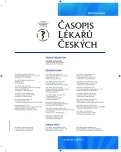Currently available skin substitutes
Authors:
Darina Oravcová 1; Ján Koller 2
Authors place of work:
Department of Plastic Surgery, City Hospital of T. Baťa, Zlín, Czech Republic
1; Department of Burns and Reconstructive Surgery, University Hospital Bratislava, Ružinov Hospital, Slovak Republic
2
Published in the journal:
Čas. Lék. čes. 2014; 153: 7-12
Category:
Přehledový článek
Summary
The current trend of burn wound care has shifted to more holistic approach of improvement in the long-term form and function of the healed burn wounds and quality of life. Autologous split or full-thickness skin graft are the best definitive burn wound coverage, but it is constrained by the limited available sources, especially in major burns. Donor site morbidities in term of additional wounds and scarring are also of concern of the autograft application. This has demanded the emergence of various skin substitutes in the management of acute burn injury as well as post burn reconstructions. This paper reviews currently available skin substitutes, produced in not for-profit skin banks as well as commercially available. They are divided according to type of material included, as biological, biosynthetic and synthetic and named respectively.
Klíčová slova:
burn – skin substitutes – biological skin substitutes – synthetic skin substitutes
Zdroje
1. Halim AS, Khoo TL, Shah JMY. Biologic and Synthetic Skin Substitutes: an Overview. Indian J Plast Surg 2010; 43(3): 23–28.
2. Demling RH, DeSanti L, Orgill DP, Jacobitz J. Use of skin substitutes. Burnsurgery.org c2000–2005 [online]; http://www.burnsurgery.org/Modules/BurnWound%201/sect_VIII.htm/
3. Shevchenko RV, Stuart LJ, James SE. A Review of Tissue-Engineered Skin Bioconstructs Available for Skin Reconstruction. J R Soc Interface 2010; 7(43): 229–258.
4. Koller J. Súčasné možnosti náhrady kože. Bratislava: Habilitation work 2004.
5. Atiyeh BS, Costagliola M. Cultured Epithelial Autograft (CEA) in Burn Treatment: Three Decades Later. Burns 2007; 33(4): 405–413.
6. Atiyeh BS, Hayek SN, Gunn SW. New Technologies for Burn Wound Closure and Healing – Review of the Literature. Burns 2005; 31(8): 944–956.
7. Koller J. Popáleniny – úvod do problematiky, výskyt, patofyziológia, klasifikácia. Bratislava: Manuscript 2003.
8. Hansen SL, Voight DW, Wiebelhaus P, Chester PN. Using Skin Replacement Products to Treat Burns and Wounds. Advances in Skin & Wound Care: The Journal for Prevention and Healing 2001 [online]; 14(1): 37; http://endoflifecare.tripod.com/imbeddedlinks/id12.html
9. Still J, Glat P, Silverstein P, Griswold J, Mozingo D. The Use of a Collagen Sponge/Living Cell Composite Material to Treat Donor Sites in Burn Patients. Burns 2003; 29(8): 837–841.
10. Johnsen S, Ermuth T, Tanczos E, Bannasch H, Horch RE, Zschocke I, Peschen M, Schöpf E, Vanscheidt W, Augustin M. Treatment of Therapy-Refractive Ulcera Cruris of Various Origins with Autologous Keratinocytes in Fibrin Sealant. Vasa 2005; 34(1): 25–29.
11. Grant I,Warwick K, Marshall J, Green C, Martin R. The Co-Application of Sprayed Cultured Autologous Keratinocytes and Autologous Fibrin Sealant in a Porcine Wound Model. Br J Plast Surg 2002; 55(3): 219–227.
12. Jones I, Currie L, Martin R. A Guide to Biological Skin Substitutes. Br J Plast Surg 2002; 55(3): 185–193.
13. Ryssel H, Gazyakan E, Germann G, Ohlbauer M. The Use of MatriDerm in Early Excision and SimultaneousAutologous Skin Grafting in Burns – A Pilot Study. Burns 2008; 34(1): 93–97.
14. MacLeod TM, Williams G, Sanders R, Green CR. Histological Evaluation of Permacol as a Subcutaneous Implant over a 20-Week Period in the Rat Model. Br J Plast Surg 2005; 58(4): 518–532.
15. Lindberg K, Badylak SF. Porcine Small Intestinal Submucosa (SIS): a Bioscaffold Supporting in Vitro Primary Human Epidermal Cell Differentiation and Synthesis of Basement Membrane Proteins. Burns 2001; 27(3): 254–266.
16. Prevel CD, Eppley BL, Summerlin DJ. Small Intestinal Submucosa: Utilization as a Wound Dressing in Full-Thickness Rodent Wounds. Ann Plast Surg 1995; 35(4): 381–388.
17. Bello YM, Falabella AF, Eaglstein WH. Tissue Engineered Skin. Current Status in Wound Healing. Am J Clin Dermatol 2000; 2(5): 305–313.
18. Uccioli L. A Clinical Investigation on the Characteristics and Outcomes of Treating Chronic Lower Extremity Wounds Using the Tissuetech Autograft System. Int J Low Extrem Wounds 2003; 2(3): 140–151.
19. Moustafa M, Bullock AJ, Creagh FM, Heller S, Jeffcoate W,Game F, Amery C, Tesfaye S, Ince Z, Haddow DB, MacNeil S. Rando-mized, Controlled, Single-Blind Study on Use of Autologous Keratinocytes on a Transfer Dressing to Treat Nonhealing Diabetic Ulcers. Regen Med 2007; 2(6): 887–902.
20. Heitland A, Piatkowski A, Noah EM, Pallua N. Update on the Use of Collagen/Glycosaminoglycate Skin Substitute – Six Years of Experiences with Artificial Skin in 15 German Burn Centers. Burns 2004; 30(5): 471–475.
21. Soejima K, Chen X, Nozaki M, Hori K, Sakurai H, Takeuchi M. Novel Application Method of Artificial Dermis: One-Step Grafting Procedure of Artificial Dermis and Skin, Rat Experimental Study. Burns 2006; 32(3): 312–318.
22. Noordenbos J, Dore C, Hansbrough JF. Safety and Efficacy of TransCyte for the Treatment of Partial-Thickness Burns. J Burn Care Rehabil 1999; 20(4): 275–281.
23. Travia G, Palmisano PA, Cervelli V, Esposito G, Casciani CU. The Use of Fibroblast and Keratinocyte Cultures in Burns Treatment. Annals of Burns and Fire Disasters 2003; 16(1) [online]; http://www.medbc.com/annals/review/vol_16/num_1/text/vol16n1p19.asp
24. Bakoš D, Jorge-Herrero E, Koller J. Resorption and Calcification of Chemically Modified Collagen/Hyaluronan Hybrid Membranes. Polim Med 2000; 30(3–4): 57–64.
25. Koller J, Bakoš D, Sadloňová I. Biocompatibility Studies of Modified Collagen/Hyaluronan Membranes after Implantation. Cell Tissue Bank 2001; 2: 135–142.
Štítky
Adiktologie Alergologie a imunologie Angiologie Audiologie a foniatrie Biochemie Dermatologie Dětská gastroenterologie Dětská chirurgie Dětská kardiologie Dětská neurologie Dětská otorinolaryngologie Dětská psychiatrie Dětská revmatologie Diabetologie Farmacie Chirurgie cévní Algeziologie Dentální hygienistkaČlánek vyšel v časopise
Časopis lékařů českých

- Přerušovaný půst může mít významná zdravotní rizika
- Top zaměstnavatelé ve zdravotnictví si hýčkají už studenty
- Mikroplasty a jejich riziko pro zdraví: Co všechno víme?
- Ukažte mi, jak kašlete, a já vám řeknu, co vám je
- Metamizol jako analgetikum první volby: kdy, pro koho, jak a proč?
Nejčtenější v tomto čísle
- Historické aspekty Smithovho-Lemliho-Opitzovho syndrómu
- Přecitlivělost na elektromagnetické pole: neexistující onemocnění?
- HELSINSKÁ DEKLARACE WMA – ETICKÉ ZÁSADY PRO LÉKAŘSKÝ VÝZKUM S ÚČASTÍ LIDSKÝCH BYTOSTÍ
- Súčasne dostupné kožné náhrady
